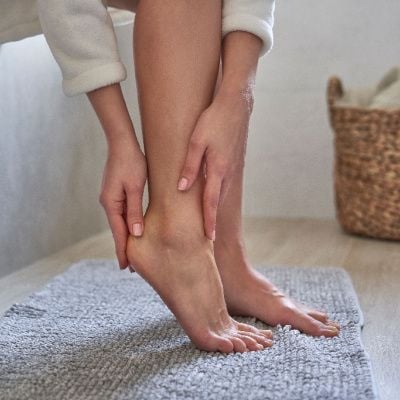 Maintaining foot health is crucial for overall well-being, as our feet bear the weight of our bodies and support us through various activities. Conducting regular foot self-exams is a proactive way to monitor for potential issues, catch them early, and ensure optimal foot function. In this article, we'll explore the importance of foot self-exams and provide a comprehensive guide on how to perform them.
Maintaining foot health is crucial for overall well-being, as our feet bear the weight of our bodies and support us through various activities. Conducting regular foot self-exams is a proactive way to monitor for potential issues, catch them early, and ensure optimal foot function. In this article, we'll explore the importance of foot self-exams and provide a comprehensive guide on how to perform them.
The Significance of Foot Self-Exams
Foot problems can arise from a variety of causes, including injuries, infections, or chronic conditions. Conducting routine foot self-exams allows individuals to identify early warning signs, such as changes in skin color, lumps, swelling, or pain. Detecting issues promptly can lead to timely intervention, preventing the progression of conditions that may impact mobility or lead to complications.
When and How Often to Perform Foot Self-Exams
Ideally, individuals should incorporate foot self-exams into their regular healthcare routine. Consider conducting a foot self-exam at least once a month, and more frequently if you have diabetes, are prone to foot issues, or have a family history of foot problems. Consistency is key, as regular exams increase the likelihood of detecting changes over time.
Choose a well-lit and comfortable space for your foot self-exam. Sit down and have a towel or cushion to place under your feet. Ensure you have a clear view of both feet, and if needed, use a mirror or ask a friend or family member for assistance.
What to Look For During a Foot Self-Exam
-
Skin and Nail Changes:
- Inspect the skin for any discoloration, redness, or rashes.
- Check for cuts, scratches, or wounds, particularly between the toes.
- Examine toenails for signs of fungal infection, ingrown nails, or changes in color and thickness.
-
Lumps or Bumps:
- Run your fingers along the surface of your feet, feeling for any unusual lumps, bumps, or swelling.
- Pay attention to the sides and bottom of your feet, as well as the arches and heels.
-
Pain or Discomfort:
- Note any areas that feel tender or painful during the exam.
- Be aware of persistent pain, especially if it worsens or interferes with your daily activities.
-
Changes in Sensation:
- Assess sensation by gently touching various areas of your feet with your fingers.
- Take note of any numbness, tingling, or loss of sensation, as these can be signs of nerve-related issues.
What to Do If You Discover Anomalies
If you observe any concerning changes during your foot self-exam, it's essential to take prompt action:
-
Minor Issues:
- For minor cuts, scrapes, or calluses, clean the area with mild soap and water, apply an antiseptic, and cover with a sterile bandage.
- Ingrown toenails may be managed at home by soaking the foot in warm water and gently lifting the ingrown edge.
-
Persistent Issues:
- If pain, swelling, or skin changes persist, seek consultation with a healthcare professional, such as a podiatrist or primary care physician.
- Any signs of infection, such as redness, warmth, or discharge, require prompt medical attention.
-
Diabetes and Foot Health:
- Individuals with diabetes should pay extra attention to their feet and seek professional guidance for any issues, as diabetes can impact circulation and nerve function.
Preventive Measures for Foot Health
In addition to regular foot self-exams, adopting preventive measures can contribute to overall foot health:
-
Proper Footwear:
- Wear shoes that provide adequate support, fit well, and suit the activity.
- Avoid wearing tight or ill-fitting shoes for extended periods.
-
Maintain Good Hygiene:
- Keep your feet clean and dry, paying attention to spaces between the toes.
- Trim toenails straight across to prevent ingrown nails.
-
Moisturize:
- Apply a moisturizer to prevent dryness and cracking, especially in areas prone to calluses.
-
Stay Active:
- Engage in regular physical activity to promote circulation and maintain overall foot function.
Conclusion
Conducting regular foot self-exams is a simple yet effective way to take an active role in your foot health. By being attentive to changes, addressing issues promptly, and adopting preventive measures, individuals can contribute to the longevity and well-being of their feet. Incorporating foot self-exams into your routine is a proactive step towards maintaining healthy and functional feet throughout life.
Disclaimer:
The information on this website is provided for educational and information purposes only and is not medical advice. Always consult with a licensed medical provider and follow their recommendations regardless of what you read on this website. If you think you are having a medical emergency, dial 911 or go to the nearest emergency room. Links to other third-party websites are provided for your convenience only. If you decide to access any of the third-party websites, you do so entirely at your own risk and subject to the terms of use for those websites. Neither Joseph Stuto, DPM, nor any contributor to this website, makes any representation, express or implied, regarding the information provided on this website or any information you may access on a third-party website using a link. Use of this website does not establish a doctor-patient relationship. If you would like to request an appointment with a health care provider, please call our office at 718-624-7537.


